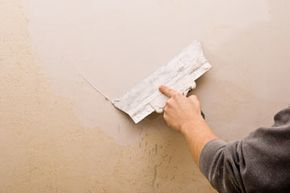Dr. Who fans might remember the spooky crack in Amelia Pond's bedroom wall that followed The Doctor through time and space. While a crack in your condo's shared wall might not be a crack in the fabric of the universe, it's still a good idea to fix it up.
A shared wall – also called a party wall or demising wall – is any wall in your unit that's also a wall in the unit next door. You probably know it as "that wall through which I can hear everything my neighbor is doing." Curtis Peart from FrontPorch, a company that's built condo complexes in Atlanta, explains that party walls are made in two parts: One supports one side and the other supports the other. It's basically two walls, and theyreduce sounds, smells and even prevent fire damage in one unit from spreading to another, depending on code requirements.
Advertisement
Shared walls already mean shared sounds, but a crack in the wall can amplify them. A cracked party wall lets more sound through and can even let smells into the adjoining unit! "When you run the vent hood while you're cooking or even open the windows, you're sucking air out of your unit putting it in a negative pressure condition, and if you have less pressure than next door, you can suck in their stinky air," Peart says.
如果一个公寓单元着火,巴勒斯坦权力机构rty wall protects the surrounding units. It does that by both keeping fire from spreading and preventing oxygen from next door from feeding the fire, Peart says. Cracks allow air through, so the bigger the crack, the bigger the hazard.
Leon Kurkjain at LPK Creations, a remodeling company in Atlanta, also points out that cracks in the wall can be a symptom of a structural problem. If the crack is larger than a "surface crack" – meaning that it's wide enough for you to insert even a piece of paper – you should talk to a structural engineer. You don't want to repair a crack only to have more appear because your building has a weak foundation.
Once you've ruled out severe issues, you can repair surface cracks yourself. Peart recommends that you "tape and bed the crack" by applyingdrywallmesh tape over the crack, spreading drywall mud over the tape, letting it dry, then sanding and painting.
In the U.S. it's courteous to let your neighbor know before you start repairing a crack in a shared wall, but legally you own your side of the party wall, so you can do whatever you want to it without talking to your neighbor. It's a different story if you're messing with the inside of the wall, and how much of the inside of the wall you own depends on where the boundary line is [source:Romano]. Your home owners association should be able to tell you that, as it can vary.
In the U.K. and Wales, however, the Party Wall Act of 1996 says that you have to notify your neighbor of any work you do on a shared wall, even if it won't go past the center line [source:Communities and Local Government].
In general, if the crack in your wall doesn't look too severe, you're probably fine to repair it yourself, but for anything that looks like it's more than a surface crack, you'll want to have an expert take a look before you attempt any DIY repairs.
Advertisement



